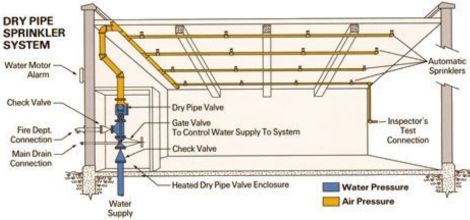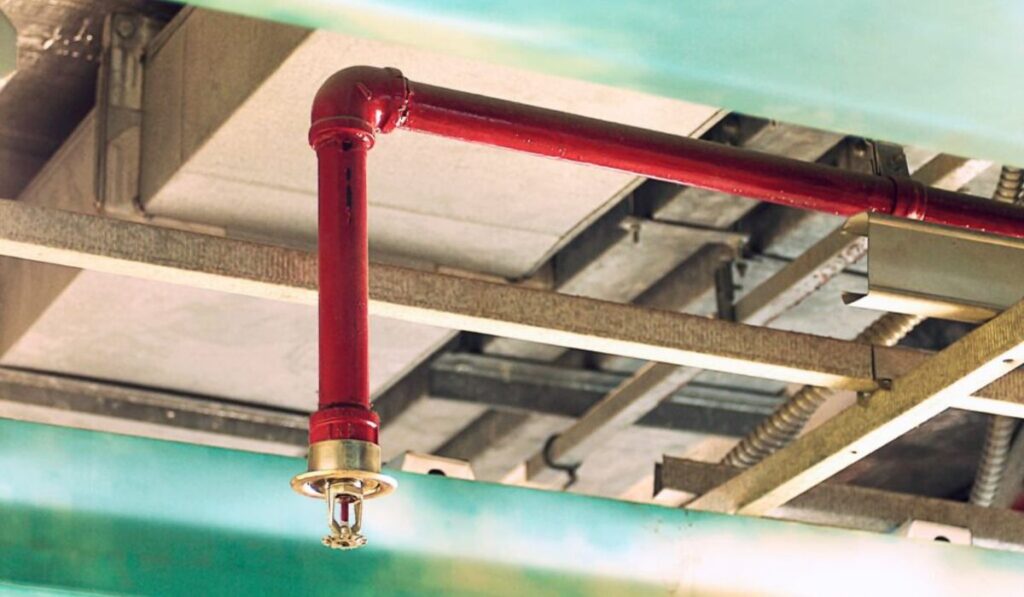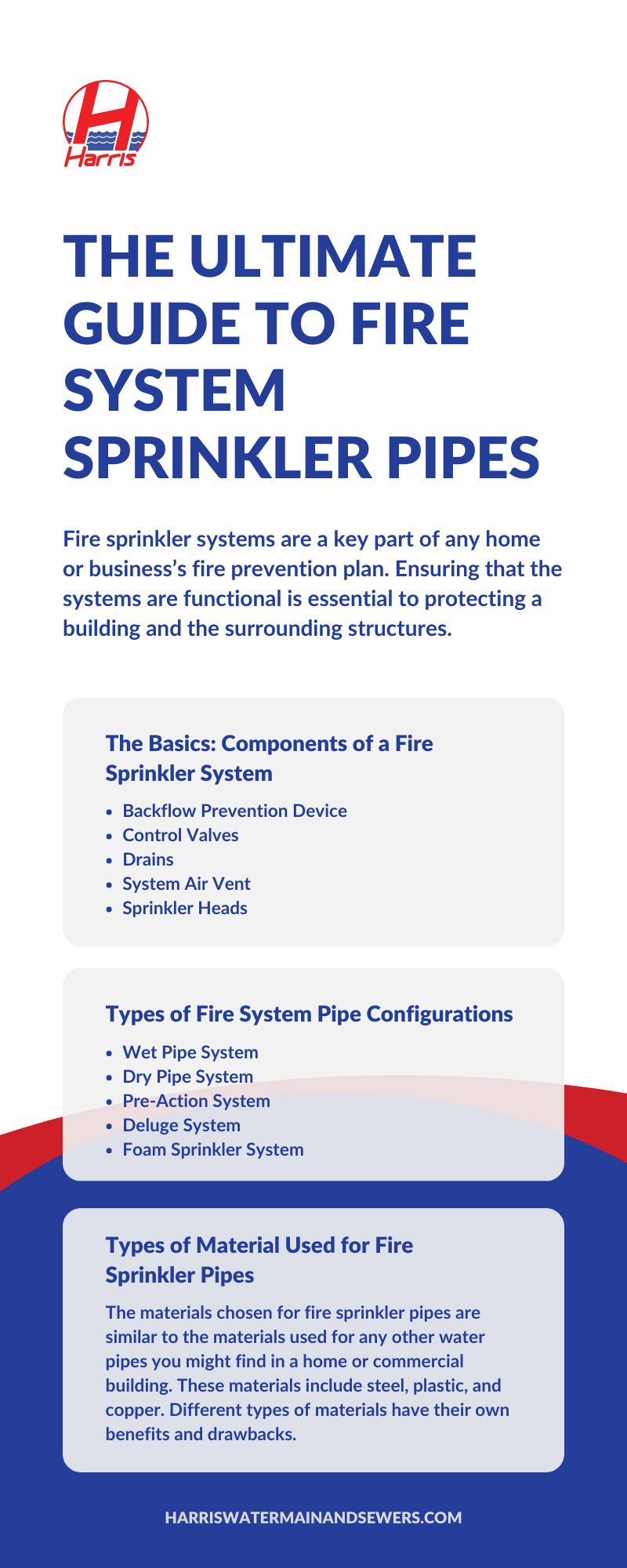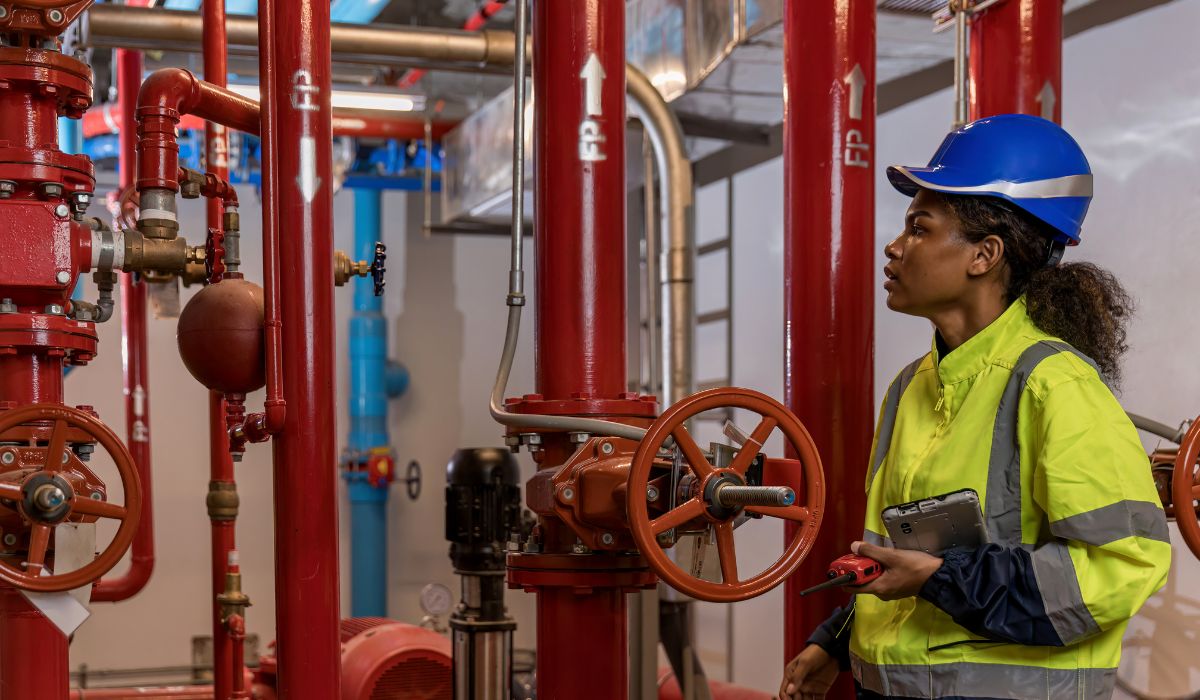Dry pipe fire sprinkler systems activate when air pressure drops in the pipes. Water then floods the system to douse fires.
Dry pipe fire sprinkler systems offer fire protection in temperatures where water in traditional sprinklers would freeze, such as in unheated buildings or outdoor structures. Their design requires a pressurized air or nitrogen-filled system that keeps water out of the pipes until a fire is detected.
Upon detection, the drop in pressure releases the valve, and water flows into the pipes and out through the sprinkler heads. These systems are ideal for spaces at risk of freezing or where water damage must be minimized. They demand precise installation and maintenance, considering the added complexity and response time compared to wet pipe systems.

Introduction To Dry Pipe Fire Sprinkler Systems
Dry pipe fire sprinkler systems play a crucial role in fire protection. They offer unique advantages, especially in environments prone to freezing or where water damage must be minimized. Unlike traditional systems, these use pressurized air or nitrogen, activating water flow only when needed.
Essential Components
Dry pipe systems consist of several key components:
- Dry Pipe Valve: Prevents water from entering the pipe until a fire is detected.
- Pipe Network: Filled with pressurized air that holds the dry pipe valve closed.
- Automatic Sprinklers: Heat-sensitive devices that trigger during a fire.
- Air Compressor: Maintains air pressure within the pipes.
- Control Panel: Monitors system status and alerts for activation or issues.
How They Differ From Wet Pipe Systems
Dry pipe and wet pipe systems differ mainly in their application and operation:
| Dry Pipe Systems | Wet Pipe Systems |
|---|---|
| Suitable for low temperature areas | Best for constant temperature environments |
| Pressurized air in pipes | Water filled pipes at all times |
| Delayed water discharge | Immediate water discharge |
Credit: www.victaulic.com
Working Principles Of Dry Pipe Systems
Dry Pipe Fire Sprinkler Systems stand guard to protect buildings from fire with a unique twist. Unlike their wet pipe cousins, these systems use air or nitrogen, not water, in their pipes. This design is perfect for places where temperatures drop below freezing. Here’s how these lifesavers spring into action when heat from a fire is detected.
Activation Process
Picture a fire breaking out. The system senses the heat and the journey to put it out begins. It all starts with the sprinkler heads. They stay closed until a pre-set temperature breaks the seal. This seal break is key.
It signals the air to dash out and the water to get ready to take center stage.
Water Delivery Mechanism
With the air gone, it’s showtime for the water. A valve, known as the dry pipe valve, opens up. This valve was the gatekeeper, keeping the water at bay while the pipes stayed dry. Now, water rushes through these pipes with one mission: to reach the open sprinkler heads. The water swoops in, dousing the flames, and gives everyone more time to get to safety.
Let’s break it down:
- Temperature rises, sprinkler activates.
- Air escapes, valve unlocks.
- Water bursts forth, fire retreats.
Ideal Applications And Environments
Fire safety is vital in every building, and a Dry Pipe Fire Sprinkler System offers unique advantages. This system is perfect for areas where the water can freeze.
Cold Climates Considerations
In places with harsh winters, water in pipes can freeze. The Dry Pipe System prevents this. Here’s why:
- It holds air under pressure instead of water.
- Only when a fire is detected does the system fill with water.
- This design stops water from freezing inside the pipes.
Such systems are ideal for unheated buildings like warehouses or parking garages.
Commercial Vs Residential Use
| Environment | Advantages |
|---|---|
| Commercial |
|
| Residential |
|
Commercial spaces often choose Dry Pipe Systems for their expansive and unheated areas. For homes, these systems safeguard areas prone to temperature drops.
Advantages Of Dry Pipe Sprinkler Systems

When it comes to safeguarding your property against fires, dry pipe fire sprinkler systems stand out. These systems have unique benefits for certain environments. Let’s explore some key advantages that make them a valuable choice.
Reduced Risk Of Freezing
Dry pipe sprinkler systems are an excellent choice for cold areas. These systems don’t hold water until a fire triggers them. This design stops water from freezing in the pipes. No freezing means no pipe bursts or damage.
- Great for unheated buildings like warehouses and parking garages
- Keeps maintenance and repair costs low
- Ensures the system works even in winter
Flexibility In Installation
These systems adapt to various structures. They do not need a heated space to work. This allows them to fit in many places quite easily.
- Perfect for complex building designs
- Install in locations where wet pipe systems won’t work
- Simple updates to existing structures
Design And Installation Considerations
When planning a Dry Pipe Fire Sprinkler System, design and installation are key to effectiveness. Properly laid out and installed systems ensure optimal performance during emergencies. Let’s look into what considerations should take priority.
System Layout
The system layout of a Dry Pipe Fire Sprinkler System must ensure comprehensive coverage. Here are factors to consider:
- Building size and complexity.
- Occupancy type and fire load.
- Local fire codes and standards.
A precise layout avoids overspray and property damage. Zones within the system manage water distribution effectively.
Installation Best Practices
Installation best practices ensure safety and functionality. Professionals follow these steps:
- Use quality materials that meet industry standards.
- Secure connections to prevent air and water leaks.
- Test the entire system for pressure and leaks.
- Label shut-off valves and control panels for easy identification.
Regular maintenance follows installation. This takes care of system integrity.
Maintenance And Inspection Routines
Keeping a Dry Pipe Fire Sprinkler System operational requires diligent care.
Regular assessments prevent malfunctions. A system in top shape safeguards lives and property.
Regular Schedule
Following a consistent routine is crucial for sprinkler maintenance.
Here’s what to include:
- Quarterly inspections for air and water pressure
- Annual full-system checks, covering pipes and valves
- Every 3 years, conduct trip tests to ensure functionality
Troubleshooting Common Issues
When problems arise, act swiftly. Common issues include:
| Issue | Solution |
|---|---|
| Low Air Pressure | Check for leaks, repair promptly |
| Water in Pipes | Drain immediately to prevent freezing |
| Valve Problems | Inspect valves, lubricate as needed |
Seek a professional’s help for complex issues.
Improving System Performance
Dry pipe fire sprinkler systems play a vital role in protecting buildings against fire. But, like any equipment, they need regular maintenance. Performance improvements can mean the difference between minor damage and a major disaster. To ensure your dry pipe sprinkler system operates efficiently, consider upgrades and routine checks. These can help achieve quick responses in emergency situations.
Upgrades And Retrofits
Keeping your system up-to-date is crucial for optimal performance. Building changes may necessitate system upgrades or retrofits. It is essential to assess the current system to identify areas for improvements. Here are some key measures:
- Replacement: Swap old parts with newer, more reliable components.
- Automation: Install electronic monitoring devices for real-time alerts.
- Alternate Materials: Use corrosion-resistant piping to prevent leaks.
Ensuring Quick Response
A swift action by your sprinkler system can drastically reduce fire damage. Steps to ensure a quick response include:
- Maintenance: Regular inspections for any signs of rust or blockage.
- Testing: Frequent testing helps identify delays in water delivery.
- Piping Configuration: Optimize the layout to minimize water travel time.
These actions help guarantee your dry pipe fire sprinkler system works fast and effectively when needed.

Credit: www.harriswatermainandsewers.com
Case Studies And Real-world Examples
Exploring real-life stories helps us grasp how dry pipe fire sprinkler systems work best. We dive into case studies to reveal their effectiveness and lessons from past failures.
Success Stories
Dry pipe sprinkler systems have saved countless structures from fire devastation. One standout example is a historic library in Massachusetts. Its dry pipe system activated during a fire, protecting rare books worth millions. A table of other notable successes includes:
| Location | Type of Property | Outcome |
|---|---|---|
| New York Warehouse | Industrial | Fire contained in quadrant of origin |
| Texas School | Educational | Minimal damage, quick resumption of classes |
| California Office Building | Commercial | No casualties, fire suppressed in early stage |
These incidents underline the system’s reliability even in freezing temperatures where wet pipe systems could fail.
Lessons Learned From System Failures
Not all systems perform flawlessly. Valuable insights come from analysis of failures. A prime example occurred in a Chicago high-rise. Faulty maintenance led to a system malfunction during a fire, resulting in significant property loss. Bullet points of other lessons include:
- Regular maintenance is critical to prevent malfunctions.
- Proper insulation and air pressure monitoring guard against system freeze.
- Immediate response to system alerts can mitigate damage.
Each failure teaches building owners the importance of vigilance and upkeep for their fire defense systems.
Understanding Local Codes And Regulations
Ensuring the safety of a building involves many factors. One key aspect is the installation of an effective fire suppression system. Dry pipe fire sprinkler systems offer reliable protection in climates where the pipes could freeze. It’s crucial to understand and adhere to your local codes and regulations. These rules are in place to protect lives and properties. They vary based on the location, type of building, and the specific use of the premises.
Compliance With Standards
To safeguard occupants, compliance with fire safety standards is a must. These standards outline the necessary specifications for dry pipe systems. They ensure optimal performance during emergencies.
- NFPA 13: This standard provides guidelines for the installation of sprinkler systems.
- International Building Code (IBC): Offers a set of rules that apply to all buildings regarding fire safety features.
- Local Amendments: Some areas may have additional requirements tailored to local risks and considerations.
Navigating Regulatory Requirements
It’s essential to navigate the regulatory requirements effectively. Builders, homeowners, and business owners should ensure systems are up to code. Here’s how you can navigate these regulations:
- Consult with local fire authorities to understand specific requirements.
- Work with licensed professionals knowledgeable in these regulations.
- Regularly inspect and maintain your sprinkler system to adhere to codes.
Conclusion And Safety Recommendations
Understanding dry pipe fire sprinkler systems is crucial for safety. These systems play a vital role in protecting buildings from fire, especially in places where temperatures drop below freezing. The conclusion of this discussion and the related safety recommendations will highlight key points to ensure these systems work effectively when needed.
Final Thoughts
Dry pipe fire sprinkler systems provide excellent fire protection. They are essential in cold environments. Their unique design prevents water from freezing. This design ensures that sprinkler pipes do not burst during cold snaps. Maintaining these systems in working order is non-negotiable for safety.
Preventative Measures
- Regular inspections are a must. These check for corrosion and blockage.
- Annual maintenance helps avoid system malfunctions.
- Replacement of parts should follow the manufacturer’s guidelines.
- Education on system use is key for building occupants.
Optimal function of these systems is essential in preventing fire disasters. Always follow the code requirements and safety protocols set by local authorities. Ensure a professional assesses the system consistently. They will make sure everything remains in order. This proactive approach saves lives and property.
Frequently Asked Questions For Dry Pipe Fire Sprinkler System
What Are The Disadvantages Of A Dry Pipe Sprinkler System?
Dry pipe sprinkler systems have delayed water delivery during fires, higher maintenance requirements, and can be less reliable in colder climates due to potential freezing. They also generally cost more to install and operate than wet pipe systems.
What Is The Difference Between A Wet And Dry Fire Sprinkler System?
A wet fire sprinkler system contains pressurized water in the pipes at all times. Conversely, a dry system holds air, which, when triggered, allows water to flow through the pipes.
What Is The Life Expectancy Of A Dry Pipe Sprinkler System?
A dry pipe sprinkler system typically has a life expectancy of around 20 years, but proper maintenance can extend its lifespan up to 40 years.
What Is The Difference Between Dry Pipe And Preaction Sprinkler System?
Dry pipe sprinkler systems fill with air, releasing water once the air pressure drops. Preaction systems require two triggers, typically smoke detection and a drop in air pressure, before water releases, helping to prevent accidental discharge.
Conclusion
Ensuring fire safety is paramount for any property owner. Dry pipe sprinkler systems present a reliable solution, especially in climates prone to freezing. They offer delayed water delivery, minimizing accidental water damage. Regular maintenance and inspections are crucial. Protect your investment; consider a dry pipe system for efficient fire suppression.

I’m Abdus Sobur, a highly skilled and professional Fire Safety Officer with a passion for safeguarding lives and property. Over the course of my career, I’ve conducted numerous successful fire safety audits, earning a reputation for excellence in ensuring public safety.
In addition to my role as a Fire Safety Officer, I’m also dedicated to raising awareness about the importance of fire safety. Through my blog, I share insights into the functions of different fire safety equipment, aiming to empower individuals with the knowledge they need to protect themselves and their communities.
I’m driven by a deep commitment to promoting fire safety awareness and preventing fire-related incidents.

